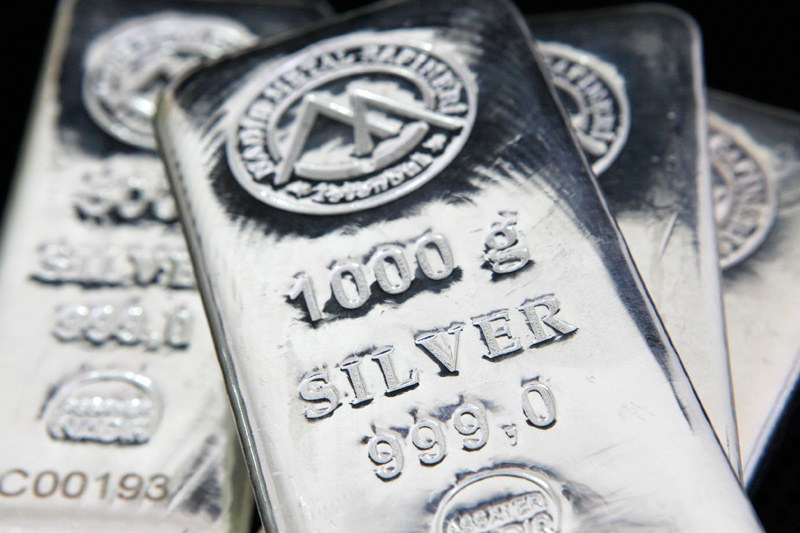Investing.com - Silver futures were lower on Wednesday as uncertainty over the future of the Federal Reserve's stimulus program weighed on appetite for the precious metal.
Moves in the silver price this year have largely tracked shifting expectations as to whether the U.S. central bank would end its bond-buying program sooner-than-expected.
On the Comex division of the New York Mercantile Exchange, silver futures for September delivery traded at USD19.35 a troy ounce during European morning trade, down 0.85%.
Silver futures hit a session low of USD19.29 a troy ounce earlier in the day, the weakest level since August 2.
Silver prices were likely to find near-term support at USD19.18 a troy ounce, the low from August 2 and resistance at USD19.77, Tuesday’s high.
The September contract settled down 1% at USD19.52 a troy ounce on Tuesday after strong U.S. trade data saw investors reassess expectations on when the Federal Reserve may start to taper its asset purchase program.
A government report showed that the U.S. trade deficit narrowed by 22.4% to a seasonally adjusted USD34.2 billion in June, the lowest level since October 2009.
Investors have closely been looking out for U.S. data reports recently to gauge if they will strengthen or weaken the case for the Federal Reserve to reduce its bond purchases.
Any improvement in the U.S. economy was likely to reinforce the view that the central bank will begin to taper its bond purchase program in the coming months.
Also Tuesday, Chicago Fed President Charles Evans said he expected the central bank to begin tapering its asset-purchase program by the end of the year.
Silver prices are on track to post a loss of almost 37% on the year, amid speculation the Fed will start to unwind its bond purchasing program in the coming months.
Elsewhere on the Comex, gold for December delivery fell 0.25% to trade at USD1,279.20 a troy ounce, while copper for September delivery shed 0.2% to trade at USD3.166 a pound.
Copper traders looked ahead to data scheduled for later in the week on China’s trade balance as well as a report on inflation and industrial production, amid ongoing concerns over the Asian nation’s economic outlook.
China is the world’s largest copper consumer, accounting for almost 40% of world consumption last year.
Moves in the silver price this year have largely tracked shifting expectations as to whether the U.S. central bank would end its bond-buying program sooner-than-expected.
On the Comex division of the New York Mercantile Exchange, silver futures for September delivery traded at USD19.35 a troy ounce during European morning trade, down 0.85%.
Silver futures hit a session low of USD19.29 a troy ounce earlier in the day, the weakest level since August 2.
Silver prices were likely to find near-term support at USD19.18 a troy ounce, the low from August 2 and resistance at USD19.77, Tuesday’s high.
The September contract settled down 1% at USD19.52 a troy ounce on Tuesday after strong U.S. trade data saw investors reassess expectations on when the Federal Reserve may start to taper its asset purchase program.
A government report showed that the U.S. trade deficit narrowed by 22.4% to a seasonally adjusted USD34.2 billion in June, the lowest level since October 2009.
Investors have closely been looking out for U.S. data reports recently to gauge if they will strengthen or weaken the case for the Federal Reserve to reduce its bond purchases.
Any improvement in the U.S. economy was likely to reinforce the view that the central bank will begin to taper its bond purchase program in the coming months.
Also Tuesday, Chicago Fed President Charles Evans said he expected the central bank to begin tapering its asset-purchase program by the end of the year.
Silver prices are on track to post a loss of almost 37% on the year, amid speculation the Fed will start to unwind its bond purchasing program in the coming months.
Elsewhere on the Comex, gold for December delivery fell 0.25% to trade at USD1,279.20 a troy ounce, while copper for September delivery shed 0.2% to trade at USD3.166 a pound.
Copper traders looked ahead to data scheduled for later in the week on China’s trade balance as well as a report on inflation and industrial production, amid ongoing concerns over the Asian nation’s economic outlook.
China is the world’s largest copper consumer, accounting for almost 40% of world consumption last year.
